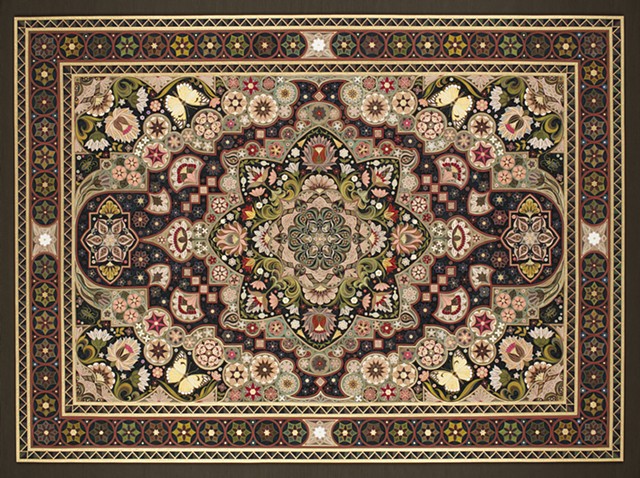Tapis Series
Grand Jardin: keeping the faith, 2016-2022
I built this piece from the center out, making design decisions as it grew.
It is one in a series of works inspired by Persian rugs called “Tapis Series” and is made of dyed Japanese mulberry paper and gilt-edged paper. The technique employed is called quilling. Paper is cut into strips, rolled into coils then pinched into various shapes that, in my version of quilling, are joined puzzle-like to each other to form the overall design.
During the making of my last piece, a much smaller one, I felt a little cramped, a bit restricted. This time, I decided to make individual design elements (flowers etc) at a scale that would more fully express what the dense quilling technique that I've been developing could do. I let the size and design of the whole go undetermined. It would be as big as it was. When I'd completed the outer border, it eventually weighed in at a little over 3 by 4 feet. I had guessed it would take maybe 6 months (perhaps a whole year?) to complete. I was shocked, when looking at a date-stamped snapshot of the work in progress, that I started it about 6 years ago.
Having a working relationship with one piece for such a long period of time brought novel thoughts and emotions, and required new things of me as an artist and as a person. The actual making of it was pretty much an ongoing delight, making decisions was sometimes torturous.
The phases of my creative process— as it progressed from the initial spark of inspiration to settling in to work, to decision-making and problem solving, to finding flow, losing flow and finding it again, to commitment and renewal of commitment—were repeated many times over the six years and within the context of widely varying moods. There were sunny hours, dreary drippy days, stormy times-- many ups and downs of my internal emotional weather. How is it possible to make something coherent with so much fluctuation coming from within and from without?
At times I was deeply engaged and at others, completely without interest. I was able to work on it intensely for months at time and then would have to find my way back in again after weeks, and occasionally months, away.
The biggest challenge was not in doing the work, but in keeping the faith, that I wasn't going to f it up with a "bad" design decision, or that I'd create a technical problem I couldn't work my way out of, that in the end, the finished work wouldn’t please, interest or impress, or that the whole would not be more than some beloved parts.
Much changed during this long sustain, the pandemic changed the world, my father passed away forever changing my world. New York Central closed, making my paper supply precious, adding a bit of adventure to the hunt for new colors and requiring some resourcefulness in using what I already had.
With works of shorter duration, the discomfort of doubt is sooner resolved, the questions are answered for better and for worse, and one can move on, try again. There is relief along with the satisfaction of completing a piece of work. Before taking on this one, I hadn’t gone without that relief for longer than a few months.
I found comfort and company in what I'd been reading about the people and circumstances of Persian rug making. There is the time-frame, many rugs take years to make. I love looking at the beautiful inconsistencies in color fields, called “abrash” that are the result of natural dying and the use of natural fibers. I am delighted when a rug maker “weaves themselves into a corner” and has to solve a tricky math/geometry problem on the fly. Improvisation is amusing in such a slow moving process.
The power and appeal of Persian rugs lies in their interplay of complex details and overall organizing structure. Much of their interest and beauty come from the inconsistencies that are inevitable when human makers work with natural materials in an every-changing environment and when the "failures" of advanced planning require improvisation and innovation. I find studying them delightful, humbling, inspiring and instructive. Their existence helps answer the aforementioned question: How is it impossible to make something coherent with so much fluctuation coming from within and from without?
My “big piece” now titled “Grand Jardin” is in the process of leaving me and going out into the world. I am curious where it will end up.
